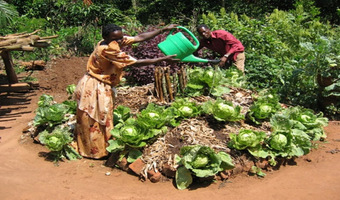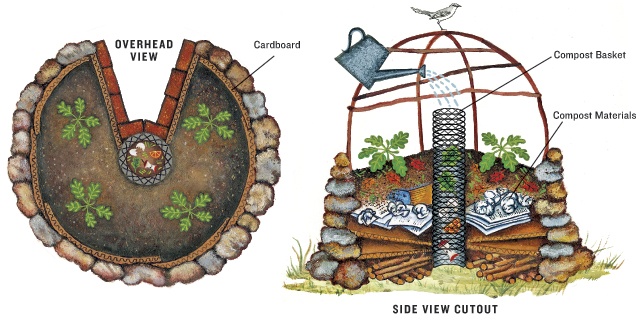 An agricultural organization is rewriting the farming script in the former war ravaged Northern Uganda with the introduction of small scale organic vegetable farming a venture that has seen the locals improve their health and increase earnings.
An agricultural organization is rewriting the farming script in the former war ravaged Northern Uganda with the introduction of small scale organic vegetable farming a venture that has seen the locals improve their health and increase earnings.
The campaign which has swept across the northern area aims at equipping the vulnerable population especially women and the elderly into sourcing for their livelihoods using the available resources and without depleting the environment. The initiative is overseen by Send a Cow Uganda a not for profit organization that is involved empowering the rural impoverished was started way back in 2010.
The program manager Send a Cow Uganda Dr Christopher Kyeswa noted that, kitchen gardens are easy to manage for they promote profitable use of water since the waste water from the kitchen will end up in the nearby gardens. For a long time, the communities living in the North have had their livelihoods shattered by the war and as a result have mainly survived on handouts from various international and local aid bodies. “We therefore deiced to initiate the Kitchen garden concept because it’s easy to adopt and also provides healthy foods using locally available meagre resources in a very short time,” explained Kyeswa.
According to him, for a farmer who is harvesting rain water, it is easy to transfer it to the garden without a lot of effort because the plantation is near home. In addition the concept only requires cheap available labour for instance, a parent can easily supervise the children to work on the gardens since it’s around the home. “Kitchen gardening requires a compost pit for manure and soil with bio-degradable because it sustains water for a longer time during a dry spell. “Kitchen gardening helps a farmer not to walk long distances for water and use less energy for farm work,” he added.
 Send a Cow Uganda has introduced a number of different kitchen gardens whose design structure depicts their naming with the most popular ones being Key Hole and Mandara. To design the Key Hole kitchen garden, one will use locally available materials like stones or brick to marked in a key like structure with a well dug in the middle which will be used for irrigating the whole garden. Line the center well with sticks or chicken wire lined with straw to initially separate the two areas. The center well is used to irrigate the whole garden bringing nutrients from the compost into the surrounding soil.
Send a Cow Uganda has introduced a number of different kitchen gardens whose design structure depicts their naming with the most popular ones being Key Hole and Mandara. To design the Key Hole kitchen garden, one will use locally available materials like stones or brick to marked in a key like structure with a well dug in the middle which will be used for irrigating the whole garden. Line the center well with sticks or chicken wire lined with straw to initially separate the two areas. The center well is used to irrigate the whole garden bringing nutrients from the compost into the surrounding soil.
Kitchen and garden wastes and gray water (or wash water) is poured into the well and used as food for the garden. “When it rains or when you water your compost, the nutrients will seep into the surrounding bed. During rainy spells you might wish to cover the compost so the nutrients in the compost do not leach out too rapidly,” explained Kyeswa. The garden is made using several layers with the height depending on one’s choice. Layering which Kyeswa explained enhance soil health can be done using: wood on very bottom, next cardboard, next a bit of compost, next petroleum-free newspaper, manure, worms, wood ash, straw, topsoil. “You can repeat, compost, straw, topsoil or some such combination until you reach desired height,” added Kyeswa.
Send a Cow encourages farmers to plant high yielding, drought tolerant and quick maturing vegetables which promise better returns. The Organization is working with over 600 smallholder farmers in the area with more new converts being registered rapidly. Susan Adong 52 from Lira is among the women who adopted the kitchen garden model in its early stages in 2010.
Currently she has six kitchen gardens beaming fresh succulent vegetables ranging from spinach, Sukuma wiki, dodo among others. Adong has been growing vegetables for both domestic use and selling the surplus. “When I started my kitchen garden farming, I had only one goal; Feeding my family of seven with better nutritional foods and saving the expenditure on the vegetable menu. However, when my vegetables matured, I realized that my family alone could not finish it because we cannot feed on it daily as we try to balance our diet. Many people from around the village approached me for vegetables and some were willing to pay handsomely because they were healthy looking and grown organically,” explained Adong. “It’s from that point that I decide to increase my kitchen gardens from two to six which I still plan to add three more in order to reap the benefits am registering,” she added. On a good month, the industrious lady earns about UGX250,000.
Due to her experience and success she has registered in Kitchen garden farming, Adong has also created a portion of her time in training other farmers around the area in its adoption and management. She advised that setting up a Kitchen garden is less costly and less labour intensive in its management. “Unlike conventional farming which require intensive labour, this type of farming uses only family labour to grow vegetables and most important requires less land,” noted Kyeswa. Send a Cow, who first popularized keyhole gardens in Africa has helped countless families and schools build keyhole and other kitchen gardens helping families mitigate the food security threat.
















Comments powered by CComment